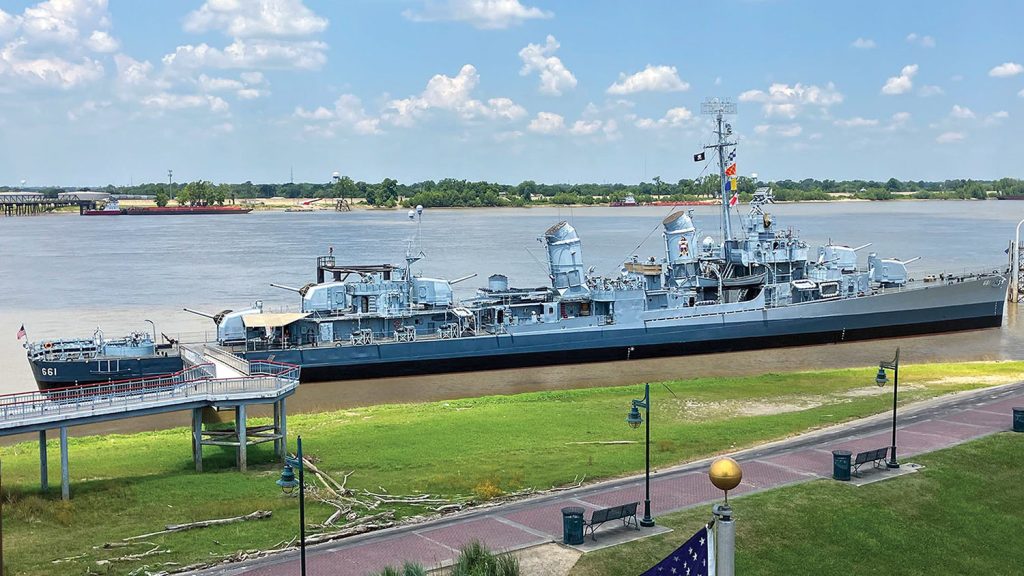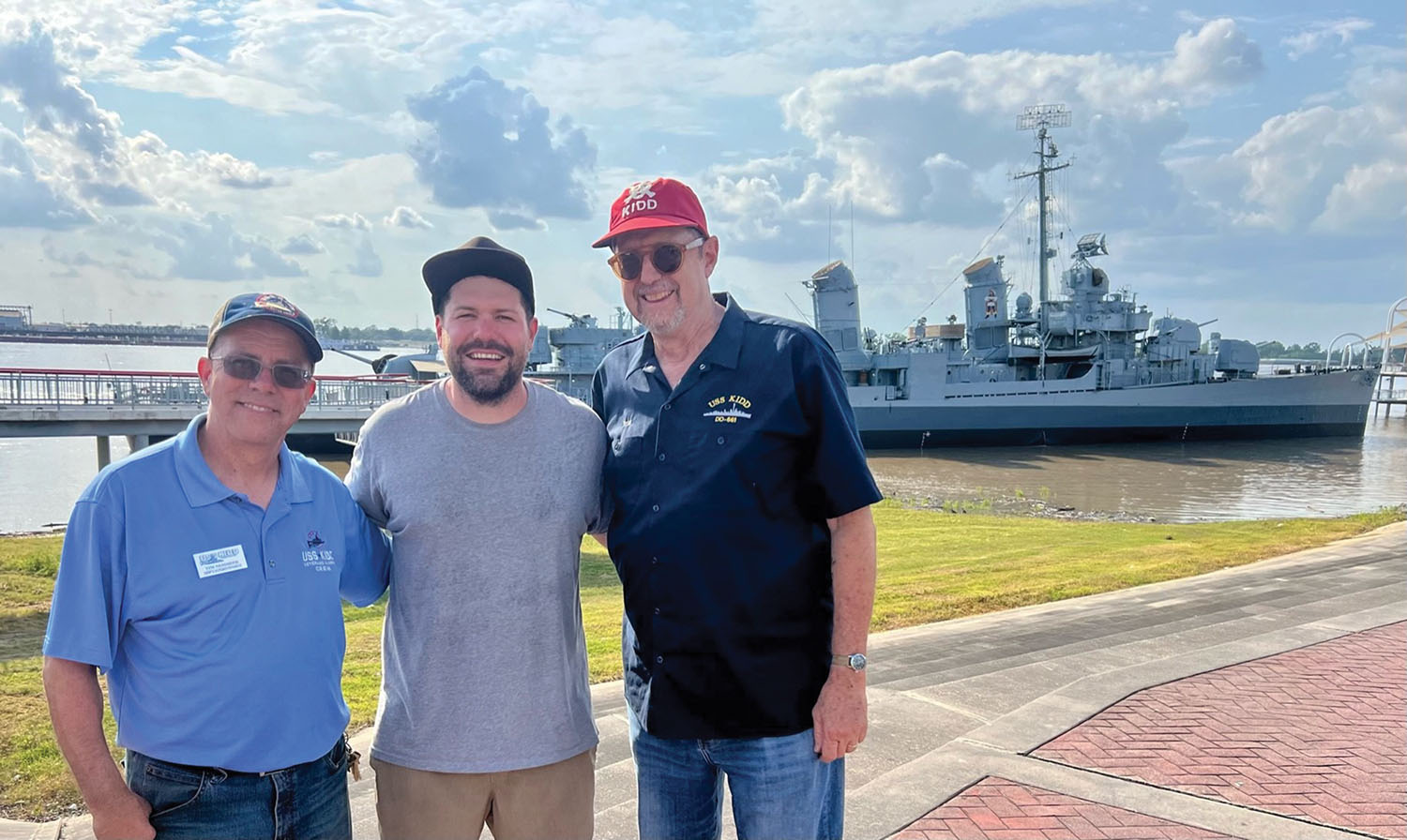When fans of the World War II destroyer U.S.S. Kidd hear that the ship is heading to drydock soon for about a year, they sometimes get the wrong impression and fear that it is a permanent move from Baton Rouge, La.
Tim NesSmith, ship superintendent and educational outreach coordinator, has found a unique way to reassure them that is not the case.
“The best way I have found to help them understand if they’re not familiar with ships and shipyards and drydocking is to compare it to our grandparents,” he said. “Grandma goes to see the doctor on a regular, scheduled basis for her continued health after a certain age. It may be once every six months. It may be once a month, but she has a regular schedule. Ships are the same way as people. Ships have to go to the shipyard to have their hulls inspected and looked at to make sure they’re not getting too thin, not getting leaks, anything that would endanger the ship’s lifespan. So that’s what we’re doing. We’re taking Kidd to her doctor’s appointment.”
Afterward, he said, the Kidd will return to Baton Rouge with repairs and upgrades meant to ensure she has a long life on public display.
The Kidd will sail under tow down the Mississippi River, into the Gulf of Mexico and around to the Thoma-Sea Shipyard in Houma, La. Conditions at its berth in Baton Rouge allowed it to be safely floated away from the custom cradle that holds it up from the muddy bottom during low-water conditions on April 25.
The three-day trip has taken months of planning, with the Thoma-Sea Shipyard one of few with a drydock size that can accommodate the destroyer, which is 376 feet long and 39 feet wide at its widest point.
Staff members hope that public tours of the Kidd may be possible during its time in drydock before returning to Baton Rouge, but those plans have not yet been finalized. NesSmith has also been in touch with the World War II Museum in New Orleans, the Houma Regional Military Museum and Jackson Barracks, the headquarters of the National Guard located next to Chalmette Battlefield, the site of the 1815 Battle of New Orleans, about the potential for providing some joint programming.
‘Pirate Of The Pacific’
Known as the “Pirate of the Pacific” because of the ship’s name being similar to that of the notorious pirate Capt. William Kidd, the U.S.S. Kidd (hull No. DD 661) is actually named after Rear Adm. Isaac Kidd, who was killed in action December 7, 1941, at the Battle of Pearl Harbor. At the request of his widow, the U.S. Navy authorized the Kidd as the only U.S. warship ever given permission to fly the skull and crossbones pirate flag. A pirate is also painted on the Kidd’s No. 1 smokestack.
The Kidd’s crews also relished their reputation as pirates by “ransoming” rescued aviators to the fleet’s carriers in return for ice cream, a practice carried on by most destroyers of the era.
While the connection to piracy is always interesting to children, adults may be more interested in the Kidd’s history, including its participation in the invasions of the Gilbert and Marshall islands and in the Battle of Okinawa in World War II.
Out of 175 Fletcher-class destroyers built for World War II, the Kidd is one of only four still in existence and the only one restored back to its World War II configuration.
Over time, the other destroyers were modified with newer, heavier weaponry for the Cold War that required modifying the structure of the ships themselves. While obsolete weaponry was removed from the Kidd, it did not receive those major structural changes, meaning it took more minor modifications to restore it to its World War II appearance.
Preserving The Kidd
While at the shipyard, work on the Kidd will focus on two primary goals: extending its lifespan by making necessary repairs and removing some modifications to restore it even more to its original configuration.
“We’ve got a few thin spots that we’ve got to crop and replace, and then we’re going to blast and paint her and get her looking good and do some preventive maintenance that can only be done in a shipyard,” NesSmith said.

While the Navy decommissioned the Kidd in 1946, it was recommissioned in 1951, called into action as part of the Ready Reserve Fleet during the Korean War. The Kidd spent time patrolling the Korean coast and bombarding targets of opportunity. With the onset of the Cold War, the Kidd participated in anti-Soviet submarine patrols, participated in fleeting operations during the Berlin Crisis of 1961 and served as a training ship before being decommissioned a second time in 1962. That later service meant some modifications that allowed the installation of radar equipment and a dumbwaiter for serving meals rather than having sailors climbing down ladders carrying trays of hot food.
As sailors sought to preserve its seaworthiness, they also poured concrete floors to level the old metal decks, and those must now be chiseled out bit by bit.
“Nobody thought these ships would be around 81 years later,” NesSmith said. “If they survived one battle, that was thought to be a success.”
One major change in the Kidd’s use of space after World War II came with President Harry S. Truman’s desegregation of the Navy in 1948. The only position available to Black crewmen before 1948 would have been as stewards’ mates, responsible for housekeeping and serving food to officers. Following desegregation, bunk and eating spaces were integrated, and some of the space was reallocated for radar equipment.
As part of the restoration work, crews will rip out the dumbwaiter and remove the radar equipment to restore those separate spaces and tell the stories related to researchers by the Black sailors who served on the ship.
“We’ve already got the bunks ready to go,” NesSmith said. “We’ve got a few of the lockers. I’m going to have to collect a few more lockers. We’re going to put it back the way it was.”
NesSmith has also pulled the crew roster, searching out the names of every Black crew member. He plans to pull their records and connect with their families, trying to learn what happened to them and tell their stories.
Upgrades To Cradle
Unlike in Europe, where ships are typically displayed by being dragged onto shore or in some cases in the United States, where they are moored on a dock built out into the river, the Kidd’s cradle system is unique, keeping it out of the busy navigation channel and allowing for seasonal water highs and lows that can vary by 40 feet.
“It’s the first instance of using that kind of system for a museum ship in the world,” NesSmith said.
Since arriving in Baton Rouge in 1982, however, the river has changed how it behaves, fluctuating more each year.
“As a result, Kidd has been impacting that cradle more and more as time has progressed,” NesSmith said.
Touch points have degraded, and it isn’t possible to do maintenance on them with the Kidd sitting on top or floating just overhead of where divers would be working, especially with extreme low visibility for divers working in the river.
While some systems use sandbags to prevent damage at touchpoints, that’s not possible either as the river current would sweep them away.
The Kidd’s absence during drydock will allow major maintenance on the cradle system. Two mooring dolphins will also be blasted and painted.
“This is kind of a once-in-a-generation event because if we do this right, it may be another 40 years, or maybe even a little bit longer before the Kidd has to leave Baton Rouge again,” NesSmith said.
Documenting The Journey
Several organizations have come together to assist with the Kidd’s journey to drydock.
Firstly, the state of Louisiana provided $10 million toward the cost of the repairs and upgrades. The public has also been invited to make donations at the Kidd’s website at usskidd.com. Donations will allow the Kidd to complete more of its list of priorities, NesSmith said.
“We would like to set up stuff for the next generation of shipkeepers to make sure they’re not having to deal with issues,” he said. “We want to do as much good as we can for the ship right here, right now so that they don’t have to take care of it as an emergency later on.”
McKinney Salvage & Heavy Lift in Baton Rouge plans to pull off and store the gangway while the Kidd is away, and Verret Shipyard in Plaquemine, La., has provided a generator for use as needed.
Hunter Svetanics of Johnson Marine Services has also volunteered his services as a cinematographer on a documentary that will ultimately be used to help tell the Kidd’s story to future generations.
Brandon Maher, the documentary’s director, works with Louisiana Public Broadcasting and lives in Baton Rouge. He became familiar with the Kidd while acting as a locations assistant to the filmmakers who produced “Greyhound,” a 2020 Tom Hanks film about World War II that was filmed in part on the Kidd.
“We’re really focusing on the ship itself and its journey,” Maher said.
Maher said the documentary is a passion project for him, and that he knew the journey to the shipyard and back would be a great opportunity to tell the ship’s story, including its service in the military, its retirement, its move to Baton Rouge, its refurbishment and its eventual homecoming.
Maher has shot footage, including some interviews, and reached out to film archives for past footage. He also plans to film its trip to Houma and visit the Kidd at the shipyard.
Maher said it may be difficult to think about, but, “In 10 more years, we won’t have any more World War II vets. It’s just a sad fact.”
That’s one reason it is important to preserve the Kidd physically and also to gather interviews and document the story visually.
“A lot of people who came before us paid the price for us to have the rights that we have, and a lot of times that price was paid with blood,” Maher said. “This is my little part of protecting that history and reminding people that the reasons they’re able to goof off on their phone and say whatever they want is because of what they did.”
Caption for top photo: From left: Tim NesSmith, Brandon Maher and Parks Stephenson are among those involved in preparing to bring the U.S.S. Kidd to drydock and chronicling the journey in a documentary. (Photo by Elijah Otto)




